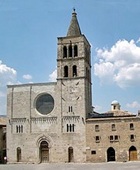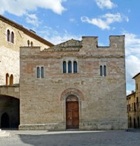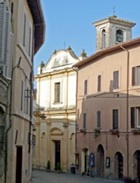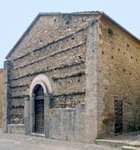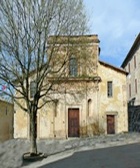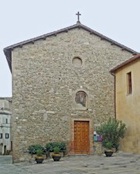

The walk begins in Piazza Filippo Silvestri, which has been the main square of Bevagna since the Middle Ages. It is named for Filippo Silvestri (1873-1949), an eminent entomologist and zoologist who was born in Bevagna.
The piazza contains three important 13th century buildings:
-
✴the ex-Palazzo dei Consoli, to the left of San Silvestro. The stairs to the left of the palace lead to the Teatro Francesco Torti. The “Pro Loco” (tourist office) of Bevagna is reached from the entrance under these stairs.
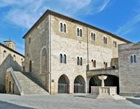
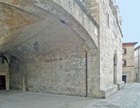

Walk along its right wall of the church ( Via Gabriele Pagliochini) to return to Piazza Filippo Silvestri.
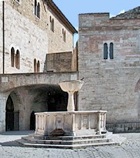
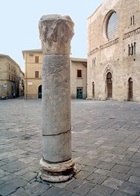
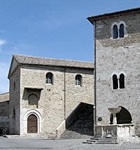
Turn right along Via del Gonfalone, which runs along the right wall of SS Domenico e Giacomo, to the Chiesa del Gonfalone and the adjacent ex-Teatro della Concordia. [Fresco (16th century) of the Madonna della Misericordia, attributed to Ascensidonio Spacca but heavily restored, in the wall of number 4 opposite.]
Retrace your steps a little way and turn right along Vicolo del Gonfalone, which runs between the Chiesa del Gonfalone and the apse of SS Domenico e Giacomo: you can see the closed window of the apse immediately on your left.
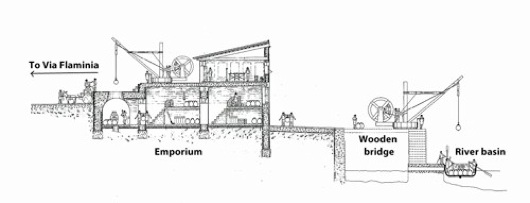
Emporium and river port, from Camerieri and Manconi (referenced below, Figure 7)
The entrance ahead, as the road swings to the right, leads to the Roman warehouse (designated as the ‘emporium’ in the reconstruction above) which extends for about 100 meters under the Convento dei SS Domenico e Giacomo, as far as Via del Cirone (below). It is possible to see inside during the annual Mercato delle Gaite. Continue to the city wall ahead and turn left along it (Via Santa Margherita):
-
✴The wooden bridge in the reconstruction above allowed goods (arriving by boat at the river port on the other side of the wall here (see Walk II) to be unloaded and moved into the emporium for onward transport on Via Flaminia (and vice versa).
-
✴The niches in the wall that supports the garden s on your left possibly belonged to a nymphaeum (ornamental fountain).
Turn left at the end of this wall, up the steps to Via Cirone: other remains of the Roman warehouse have been discovered in the cellars of the houses on your right in this street.
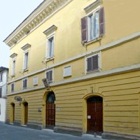
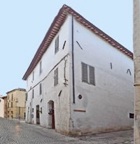
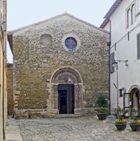
Continue along Corso Giacomo Matteotti to the junction of with Via Gabriele Crescimbeni (to the left) and Via Santa Margherita. These two streets probably formed the decumanus maximus, and the junction was probably the site of the Roman forum:
-
✴Via Gabriele Crescimbeni runs to Porta Cannara in the medieval walls; no trace survives of its Roman predecessor, which must have been a little way beyond it; and
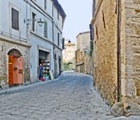
-
✴Via Santa Margherita runs to the church of Santa Margherita, which stands on what must have been the site of another Roman gate.
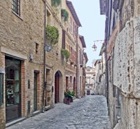
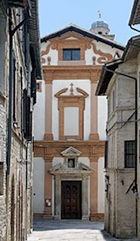

An extraordinarily well-preserved Roman building (1st century AD), complete with extensive mosaic flooring, has been excavated in the inner courtyard of the house at number 9 on the right. Although it cannot be visited, it is described and illustrated in the book edited by Annarita Falsacappa et al. (referenced below, at pp. 51-4).
Retrace your steps along Corso Giacomo Matteotti to Via Dante Alighieri, on the right. This is the site of what is now the hotel Orto degli Angeli. It comprises two historic palaces that were joined by a pensile garden in 1710:
-
✴the original Palazzo Andreozzi, with the entrance to the hotel at 1 Via Dante Alighieri; and
-
✴Palazzo Alberti, the loggia of which can be seen from this point, which ahs its main facade in Piazza San Francesco (below).
The complex was bought in 1788 by Carlantonio di Crispolto Angeli, and the hotel still belongs to his descendants.
Fork right along Via del Teatro Roamno, which runs along the right side of Restaurant Redibis (the restaurant belonging to the hotel). This restaurant and all the other properties ahead on your right stand on the site of the Roman theatre. Continue into Piazzetta del Teatro Romano: the shop at number 11 sells tickets to see part of the remains of the theatre and of a reconstruction of one of the medieval houses that were built into them.
Turn left on leaving the medieval house and left again, to continue Via del Teatro Romano (along the line of the Roman theatre): there is a lovely view of the campanile of San Francesco (below) from here. Continue into Piazza San Franceso, with the facade of Palazzo Alberti (above) on your left. The entrance to San Francesco is on the right. The primary school to the left of it occupies the ex-convent and its cloister.
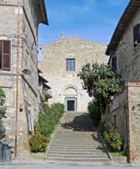
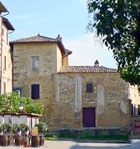
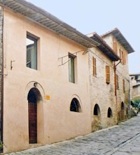
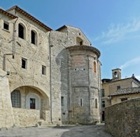
Continue for another block, into Piazza San Filippo: on the left:
-
✴a house that belonged to Filippo Silvestri is opposite.
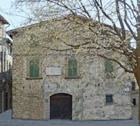
(Both were in restoration at the time of my visit in June 2017). The torso of a what was probably a Roman statue of Dionysus that was found here during the construction of San Filippo Neri in 1725 is now in Museo Capitolino, Rome.
On leaving the church, cross the piazza diagonally to your left and leave it by Vicolo San Filippo to return to the Corso, now named Corso Giovanni Amendola. (Giovanni Amendola, like Giacomo Matteotti, was an early victim of the Fascist violence of Benito Mussolini).
You now pass two palaces (18th century) on the left that belonged to the Spetia family:
-
✴Palazzetto Spetia de Cupis, at number 19-23, with remnants of an earlier palace incorporated into its facade; and
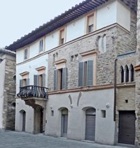
-
✴Palazzo Spetia, at number 25-7, opposite Piazza Spetia. [Roman inscriptions from the family’s villa at Pilone (see walk II) are kept here.]
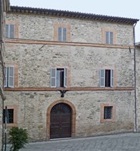
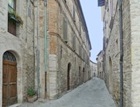
Continue past the ex-church of Santa Lucia at number 43 on the left, noting the damaged fresco (15th century) of the Madonna and Child above the portal. The adjacent ex-nunnery extended along the rest of the block (numbers 45-53) and around the corner into Piazza dell’ Asilo.
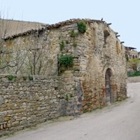
Continue to the junction with Via Porta Molini and turn turn left along it. Continue up the steps into Via Gabriele Pagliochini and back into Piazza Filippo Silvestri, where the walk ends.
Read more:
A. Falsacappa et al. (Eds), “Bevagna, Gemma del Piano: Immagini Insolite e Storie Inedite”, (2013) Spello
P. Camerieri and D. Manconi, “Le Centuriazioni della Valle Umbra da Spoleto a Perugia”, Bollettino di Archeolgic Online, (2010) 15-39
Return to Walks in Bevagna.
